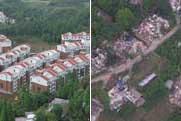China
Why Washington plays ´Tibet Roulette´ with China
Washington has obviously decided on an ultra-high risk geopolitical game with Beijing's by fanning the flames of violence in Tibet just at this sensitive time in their relations and on the run-up to the Beijing Olympics. It's part of an escalating strategy of destabilization of China which has been initiated by the Bush Administration over the past months, and which includes the attempt to ignite an anti-China Saffron Revolution in the neighboring Myanmar region, bringing US-led NATO troops into Darfur where China’s oil companies are developing potentially huge oil reserves. It includes counter moves across minerals rich Africa. And it includes strenuous efforts to turn India into a major new US forward base on the Asian sub-continent to be deployed against China.
The current Tibet operation got the
Another especially active anti-Beijing organization is the US-based Students for a Free Tibet, founded in 1994 in New York City as a project of US Tibet Committee and the NED-financed International Campaign for Tibet (ICT). The SFT is most known for unfurling a 450 foot banner atop the Great Wall in China; calling for a free Tibet, and accusing Beijing of wholly unsubstantiated claims of genocide against Tibet. It makes good drama to rally naive students.
The SFT was among five organizations which this past January that proclaimed start of a "Tibetan people's uprising" on Jan 4 this year and co-founded a temporary office in charge of coordination and financing.
Harry Wu is another prominent Dalai Lama supporter against Beijing. He became notorious for claiming falsely in a 1996 Playboy interview that he had "videotaped a prisoner whose kidneys were surgically removed while he was alive, and then the prisoner was taken out and shot. The tape was broadcast by BBC." The BBC film showed nothing of the sort, but the damage was done. How many people check old BBC archives? Wu, a retired Berkeley professor who left China after imprisonment as a dissident, is head of the Laogai Research Foundation, a tax-exempt organization whose main funding is from the NED.9
Among related projects, the US Government-financed NED also supports the Tibet Times newspaper, run out of the Dalai Lama's exile base at Dharamsala, India. The NED also funds the Tibet Multimedia Center for "information dissemination that addresses the struggle for human rights and democracy in Tibet," also based in Dharamsala. And NED finances the Tibetan Center for Human Rights and Democracy.
In short, US State Department and US intelligence community finger prints are all over the upsurge around the Free Tibet movement and the anti-Han Chinese attacks of March. The question to be asked is why, and especially why now?
Tibet's raw minerals treasure
Tibet is of strategic import to China not only for its geographical location astride the border with India, Washington's newest anti-China ally in Asia. Tibet is also a treasure of minerals and also oil. Tibet contains some of the world's largest uranium and borax deposits, one half of the world's lithium, the largest copper deposits in Asia, enormous iron deposits, and over 80,000 gold mines. Tibet's forests are the largest timber reserve at China's disposal; as of 1980, an estimated $54 billion worth of trees had been felled and taken by China (and still today a Tibetan can be arrested for taking one tree) Tibet also contains some of the largest oil reserves in the region.10
On the Tibet Autonomous Region's border along the Xinjiang Uygur Autonomous Region is also a vast oil and mineral region in the Qaidam Basin, known as a "treasure basin." The Basin has 57 different types of mineral resources with proven reserves including petroleum, natural gas, coal, crude salt, potassium, magnesium, lead, zinc and gold. These mineral resources have a potential economic value of 15 trillion yuan or US$1.8 trillion. Proven reserves of potassium, lithium and crude salt in the basin are the biggest in China. And situated as it is, on the "roof of the world," Tibet is perhaps the world's most valuable water source. Tibet is the source of seven of Asia's greatest rivers which provide water for 2 billion people." He who controls Tibet's water has a mighty powerful geopolitical lever over all Asia. But the prime interest of Tibet for Washington today is its potential to act as a lever to destabilize and blackmail the Beijing Government.
Washington's 'nonviolence as a form of warfare'
The events in Tibet since March 10 have been played in Western media with little regard to accuracy or independent cross-checking. Most of the pictures blown up in European and US newspapers and TV have not even been of Chinese military oppression of Tibetan lamas or monks. They have been shown to be in most cases either Reuters or AFP pictures of Han Chinese being beaten by Tibetan monks in paramilitary organizations. In some instances German TV stations ran video pictures of beatings that were not even from Tibet but rather by Nepalese police in Kathmandu. 11
The western media complicity simply further underlies that the actions around Tibet are part of a well-orchestrated destabilization effort on the part of Washington. What few people realize is that the National Endowment for Democracy (NED) was also instrumental, along with Gene Sharp's misnamed Albert Einstein Institution through Colonel Robert Helvey, in encouraging the student protests at Tiananmen Square in June 1989. The Albert Einstein Institution, as it describes itself, specializes in "nonviolence as a form of warfare." 12



